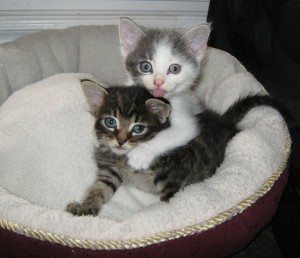This post may contain affiliate links, or we may earn money from the companies mentioned in this post. For more information on this, please visit our legal page.

I found heather through her wordpress site and saw that she was a cat fosterer and after reading some of her posts I knew I wanted to interview her and find out what it’s ACTUALLY like. Heather volunteers for the Toronto Cat Rescue in Toronto, Canada so she will share her experiences from there. They rely entirely on donations and do 2 large fundraisers a year.
So a bit about Heather…
She is a born and bred Canadian from Toronto and whilst living there all her life has two resident cats and a never-ending stream of fosters whilst still working a full time job. With an obvious passion for cats, rescuing and neutering advocacy (something we share) it is obvious that she is a strong and kind hearted woman who manages to share the love around among all the cats she cares for as well as volunteering for the Toronto Cat Rescue.
*I would like to say thank you to Heather for allowing me to interview her as well as for all of her hard work being a fosterer. Everything in red is me and my notes from the interview and everything in black is all Heather!*
About Toronto Cat Rescue (TCR)
What they do

I foster for Toronto Cat Rescue (TCR). Different rescues operate in different ways, so I can only talk about how TCR does things. TCR has been around for over 20 years, I’ve been fostering with them for 2.5 years. TCR does not have a shelter; all our cats are in foster homes.
In 2014 Toronto Cat Rescue teamed up with Toronto Animal Services (TAS) in an attempt to help make TAS a “no kill” shelter. TCR takes the “unadoptable”, the high risk, the urgent care cases, out of the shelter and into foster homes. It is truly amazing to see the difference a home environment can make in the personality – and health! – of a cat!! At any given time, TCR has about 500 cats in 400 foster homes and we adopt out about 2000 cats each year. Most of our cats come from TAS though we also take in strays and, since word has gotten out about our adoption success rate, we are often asked to assist shelters from all over southern Ontario and into Quebec.
At Toronto Cat Rescue, fosters do not pay for veterinary costs – whether visits, tests, or medications – or medically necessary diets. We do pay for all regular food, litter, toys, and supplies. Fortunately, TCR is a registered charity and if we save up all our receipts we can submit them for a charitable tax receipt. Luckily Canada has pretty good “return rate” on charitable contributions!
Their process
Almost all the cats have to be quarantined for two weeks if the foster home has other animals. (Due to volume, and through no fault of their own, shelters harbour every common cat disease there is.) This, not only protects the other animals from possible infection, but gives the foster time to observe and evaluate the animal. When the cat is deemed “adoptable” (no health/behaviour/socialization issues) they are posted on the TCR website. Fosters are responsible for writing the cat biographies and supplying photos. It is imperative that the bios be honest and accurate; one adopter’s “negative” is another’s “I MUST have this cat”. In addition, we don’t want to create unrealistic expectations – that just results in returned cats.

Some cats are adopted from home – that’s the best because you get to meet the adopter(s) and see everyone go home happy. Kittens are often placed in stores because the exposure means they get adopted very quickly. Occasionally adult cats are also placed in stores and every few months there are adoption event weekends with lots of cats in stores. (I should point out that since 2011 it has been illegal to sell dogs or cats in pet stores in Toronto. Almost all pet stores now partner with a rescue group and have either an adoption centre in the store or a habitat for one or two cats available for adoption.)
When a potential adopter has chosen a cat from the website, they call our adoption hotline. They are then screened by adoption counsellors for their suitability as adopters but also for their suitability for the cat they’ve chosen (and vice versa). One of the counsellors recently put it a great way: he thinks of himself as a matchmaker, not a gatekeeper. If the adoption counsellor thinks it’s a good match, they’ll put the adopter in touch with the foster. A meet and greet – in home – is scheduled. I’ve found some adopters come completely prepared to adopt. Others really just want to meet the cat first. I have the final say and am completely free to turn down an adopter if I think it’s necessary. I haven’t yet, but I know other fosters who have. Again, not because the adopter was “bad” but because it was a bad match with unrealistic expectations. One adopter (who spent half an hour on the floor encouraging a timid cat into her lap) asked me, “Does anyone ever not adopt the cat?” Sure, I said. She was shocked, but I think it’s a good thing. The match has to be right for everyone.

What made you decide to become a fosterer?
My two resident cats are from TCR (Toronto Cat Rescue) and they are so awesome that I wanted to give something back.
What kind of background do your cats have?
All kinds!!! I’ve had “regular” strays, returned cats (TCR has a policy that they will take back any cat they’ve adopted out, for any reason, for the life of the cat), cats from hoarding situations, surrendered-to-the-shelter cats. Some are completely well-adjusted and just need a way-station until they’re adopted. Others need a lot of nursing care until they’re healthy enough to be adopted. Still others need socialization work and time to build – or re-build – trust in people. The youngest I’ve had were two-and-a-half week old orphan bottle-feeders and the oldest was estimated at 14 years. (She also had some chronic health issues but was adopted by a wonderful young woman who “wanted to give a cat a home who’d have a hard time finding one”!!!)
What is your favourite part of fostering?
Seeing happy and excited adopters! I see them at home adoptions, of course. This past summer I was volunteering at the city’s “Mega Adoption event” (Note: that’s a whole post of its own!) and my job was to escort new adopters out with their cats, completing their city license paperwork on the way. One woman was seemingly calm and unemotional the whole time. Until she stood up after completing her final paperwork and proceeded to actually do a “happy dance” right there. I handed her the carrier and off she went with the biggest perma-grin on her face!
Of course having tiny kittens to play with sometimes is pretty great, too.

How long do you foster for?
When you foster, you take a cat/cats/kittens into your home for an indefinite period of time. I’ve had cats for a little as five days and my longest (just adopted!!) was seven months. Some fosterers have had cats for years. There are so many factors. I had one guy, Arthur, who was only supposed to be with me two weeks when we discovered he had crystals in his urine. That meant six weeks of special food and a re-test before he could even be posted. My seven month girl is very skittish – definitely not a lap cat. When we posted her – with an honest description – it took five months but an adopter came forward who wasn’t interested in a lap cat and who was completely willing to be patient and earn her trust.
Any bad points?
Worrying about sick cats and one truly terrifying middle-of-the-night race to an emergency vet. I am very fortunate to not have lost any in my care yet (though one did die of the abominably horrible disease FIP a week after he was adopted) but I know fosters who have.
As part of a rescue group I’m also exposed, more than the average person I think, to the horrible things that animals are forced to endure. We talk a lot about guarding against “compassion fatigue”. Also I’m not keen on leaving my fosters at adoption events. I know it’s necessary, but the first time I had to do it I sobbed all the way home.
Current Cats in your care
Right now I have two. Four month old “Ella” who the vet has determined was likely deprived of oxygen at birth. They thought she was deaf (nothing wrong with her hearing!) and almost blind (she does have limited vision, we’re just not sure how limited). She’s a little “slow” and a little uncoordinated. But she is the happiest, (I LOVE my food, I LOVE my toys) and most affectionate little kitten I think I’ve ever seen!

“Joe” is two years old and came to TCR from a shelter just outside the city. He is affectionate and calm, has clearly been a pet, and loves drinking from the tap. Right now we’re having a bit of a peeing issue (so common, unfortunately) that I think is territorial. If I can’t resolve it, he’ll be tested to make sure it’s not a health issue, and possibly moved to a foster home without other cats.
Favourite rehoming story
My favourite adoption story was JJ’s story, which you can find here.

And of course Leah’s story. Leah, who the emergency vet (with some good reasons) thought we should euthanize and, who is now happy and healthy in her forever home. Fortunately, as a foster, I don’t make those decisions and the executive member who was backing me up on the phone insisted they do their best to get her through the night.

How did you become a fosterer?

Everyone asks “How can you give them up?” And I did think long and hard – including considering the effect on my own two cats – before I decided to do it. TCR has an application process, then an interview. If you “pass” then, voila, you’re a foster. (TCR has a GREAT network of support, including a Facebook page just for fosters to seek advice, commiserate, celebrate successes and support each other in times of sadness.) Every few days all the foster homes receive an “intake list” of cats who need to be fostered. TCR foster homes have a “two cage” limit: we are only allowed to take as many fosters as could be in two cages (say, at an adoption event). So, a family of kittens is a “cage”; a bonded pair is a “cage”; and a solitary cat is a “cage”. Some fosters only ever take one cat at a time. My maximum was ten (a queen with eight kittens and an adult foster). Some fosters can’t or don’t want to take on medical issues, some only take nursing queens and their kittens. Sadly, there are always plenty of cats to choose from and TAS still hasn’t achieved “no kill” status.
Anything Else you would like to add?
I’m pretty passionate about spaying and neutering! I know different countries have different attitudes about it, but here in North America, the stray and feral cat population is out of control. It’s estimated that Toronto, a city of just over 2.5 million people, may have more than 100,000 stray or feral cats! Most of the major cities across the country are the same. For people who think cats can manage on their own, I wish they’d seen Benson when I got him; loving and sweet and weighing less than half of what he should have weighed. Or the three different kittens in one week that TCR took in after they’d been hit by cars and needed surgery. For people who think birthing is natural and easy for cats, I wish they’d seen Leah when she was dying of septic shock before my eyes because she had TWO dead fetuses inside her for a week. (I’ve since found out this is a lot more common than people think.) Every foster I know, every rescue group I follow, wishes we didn’t have to do what we do.
This is something Heather and I definitely agree on! – Checkout the Neutering Advocacy Page for more information
Where can we find more of you?
Blog: Slippery Slope Blog
To get more information on Toronto Cat Rescue visit their;
Website: http://www.torontocatrescue.ca
Facebook: Toronto Cat Rescue
*All Photos are courtesy of Heather*
I’ve Linkied this post too:
14 comments on “Canadian Cat Fostering”
Comments are closed.


i belong to several cat and dog groups on Facebook here in Dubai and they are always advertising for people to foster, short term, unloved/unwanted pets. it’s a fantastic idea while waiting to rehome an animal
definitely and it’s great for those who are animal lovers who can’t commit long term! x Thanks for commenting
A lady down the road to us fosters cats – up to 20 at a time, I think, and she is involved in cat neutering programmes. I take my hat off to her … and her eternally patient husband! Thank you for adding this positive feline post to #AnimalTales
Hi Charlotte, this makes for such an interesting post! Its so great to read about so many positive stories which started out quite differently. It was shocking to realise how many stray and feral cats there are in such a developed country, it makes me wonder what its like in other countries too. Really interesting! Thanks for linking up to #MarvMondays again 🙂 Emily
Hi Charlotte, I found your post very interesting. Living in a place where stray dogs and cats are common, I have seen first hand the difference foster families can make to these animals. I know many people who foster dogs and take my hats off to them, we were asked to foster a dog once and she made herself so at home with our other dogs that we couldn’t part with her (I’m not foster parent material).
Spay/neuter programs are also vital as not only does it keep down the feral population it gives the cats that sadly don’t have homes or are too feral to be homed a better life outside.
Keep up the good work Heather!
xx
I love this post, we rescued all our cats. Our first two we got from the vet, they had been abandoned and were covered in fleas and very unwell. Unfortunately after they were desexed the female kitten passed away, her brother Toby is still well, healthy and loves cuddles. We went on to get Toby a friend called Pumpkin from a rescue shelter she was in a carers home. A few months later we adopted Avari from the same shelter she was in a cage at the shelter. Pumpkin is very beautiful and glamorous but doesn’t like hugs, Avari thinks she is a dog and sits and plays with the dogs she is very fluffy so the kids call her fluffy pants. Thanks for sharing this important message.
Such an interesting read Charlotte. I too had never heard that you could foster cats, such a great idea – surely better for the kitty to be in a loving home than in a pen until a forever home is found. Sadly we wouldn’t be able to foster because I don’t think our own cat would tolerate opening his home to other cats. And like Stella above I’d no doubt fall in love with every one of the cats and end up adopting them!
Angela x
What a wonderfully lovely thing to do. Those cats are so lucky to have you to look after them (and you are lucky to have them to look after!).
What a lovely thing to do! I would love to do something like this, but I know it would stress one of my cats out and he has a heart mummur.
I wish I could foster, but I couldn’t, I would adopt them all and end up over run with gorgeous kitties. I admire you for being able to do so and save all those lovely kitties.
Fostering cats is a good idea, especially if you have the space for it! Now I’m thinking of suggesting this to the cat lady in our village who is known for luring other cats into her home and then claiming them as her own! She’s done it to our cat and our neighbours cat! I think she ought to put her obsession with cats in the “right way” 😉 #animaltales.
Ha ha, nice idea 🙂
This post needs an adorable warning with all these cat pics! I have unofficially fostered a few moggies in my time, I didn’t realise you could do it formally. #MarvMondays